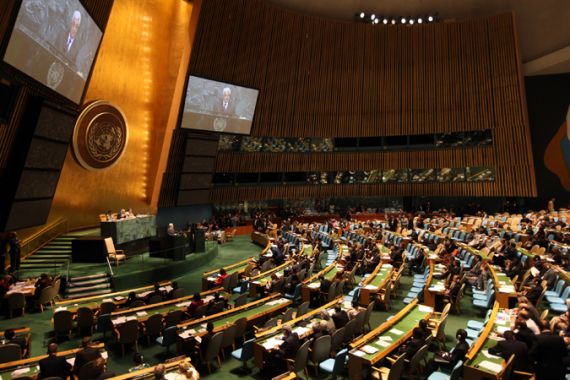Timeline: Key moments at the United Nations
A look at some of the most important UN resolutions on the subject of Israel and Palestine.

The United Nations has passed more than 150 resolutions regarding Israel and Palestine since 1947, by far the most it has considered on any one subject.
The timeline below summarises some of the most important resolutions. You can use the arrows, or the left and right arrows on your keyboard, to navigate through the timeline.
Resolution 181: The UN Partition Plan

This resolution called for the division of Palestine into two states, one Jewish, the other Arab, with an “international regime” to administer Jerusalem.
The resolution spelled out, in detail, the boundaries for the two states. The Jewish state was to receive 56% of Mandate Palestine, an area which contained a population of 498,000 Jews and 407,000 Arabs, according to a United Nations report issued at the time. The Arab state would contain 725,000 Arabs and 10,000 Jews.
Jerusalem, which would be under the purview of the United Nations, had a population of 100,000 Jews and 105,000 Arabs.
The resolution required both states to protect the rights of minorities, and to ensure free access to holy sites.
Both states were also required to establish an “Economic Union of Palestine,” which would create, among other things, a common currency and a customs union.
Resolution 194: Jerusalem and the right of return

This resolution was passed near the end of the 1948 Arab-Israeli war, and after the events of the nakba (“catastrophe”), the expulsion of more than 700,000 Palestinians from their homes.
The most significant aspect of this resolution is article 11, which enshrines a right of return for Palestinian refugees:
The General Assembly… resolves that the refugees wishing to return to their homes and live at peace with their neighbours should be permitted to do so at the earliest practicable date, and that compensation should be paid for the property of those choosing not to return and for loss of or damage to property which, under principles of international law or in equity, should be made good by the Governments or authorities responsible.
Israel insists that the resolution does not guarantee a right of return, since it states that refugees merely “should be permitted” to return.
Other provisions of resolution 194 call for a demilitarised city of Jerusalem, and for “all residents of Palestine” to have free access to the city.
Resolution 1001 (ES-1): The Suez Crisis

This resolution was the result of the United Nations’ first-ever emergency session during the Suez Crisis in November 1956.
Resolution 1001 created the United Nations Emergency Force, the international peacekeeping body stationed on Sinai until it was expelled by the Egyptian government before the Six-Day War. (A successor to UNEF was created following the 1973 war.)
The first troops arrived on Sinai eight days later, and UNEF reached its full complement of 6,000 troops by February 1957. Troops were drawn from 11 countries, with several others providing logistical support.
This resolution followed several other Suez-related resolutions, including 997, which called for a cease-fire and the withdrawal of troops to the 1949 armistice lines.
Resolution 242: The “1967 borders”

This resolution was adopted following the Six-Day War in 1967 between Israel, Egypt, Jordan and Syria.
Israel had significantly expanded its territory by the end of the war, seizing control of the Sinai Peninsula, the Gaza Strip, the West Bank, East Jerusalem and the Golan Heights.
Resolution 242 called for the “withdrawal of Israel armed forces from territories occupied in the recent conflict.” This is generally interpreted as a demand for Israel to withdraw from all occupied territory, though Israel has insisted that a partial withdrawal is acceptable under the wording (because it does not state “all territories”).
The resolution further links Israel’s withdrawal to peace with its neighbours:
Termination of all claims or states of belligerency and respect for and acknowledgement of the sovereignty, territorial integrity and political independence of every State in the area and their right to live in peace…
In other words, this resolution laid the foundation for the “land for peace” formula, which has been at the heart of the so-called “peace process” ever since.
Resolution 338: After the 1973 war

This resolution was passed near the end of the October 1973 war between Israel and a coalition of Arab states (led by Egypt and Syria).
It is essentially just a reaffirmation of resolution 242: It calls for all sides to respect a cease-fire within 12 hours, and then urges them to “start immediately after the cease-fire the implementation of Security Council resolution 242 in all of its parts.”
The resolution was passed by a 14-0 vote, with one member, China, abstaining.
The cease-fire quickly unraveled, though, in part because US Secretary of State Henry Kissinger urged the Israeli government to advance its positions in the hours before the truce took effect.
The Security Council would pass two more resolutions, 339 and 340, over the next three days; the latter finally resulted in a lasting cease-fire.
Resolution 3379: “Zionism is a form of racism”

This resolution, titled “Elimination of all forms of racial discrimination,” described Zionist ideology as racist.
It mentioned, among other things, a 1975 conference of the Organisation of African Unity (a precursor to the African Union), which compared Zionism to South African apartheid:
… “the racist regime in occupied Palestine and the racist regime in Zimbabwe and South Africa have a common imperialist origin, forming a whole and having the same racist structure and being organically linked in their policy aimed at repression of the dignity and integrity of the human being.”
The resolution went on to declare Zionism “a form of racism and racial discrimination.”
It passed in the General Assembly by a 72-35 vote, with 32 countries abstaining. The Israeli ambassador described the resolution as “anti-Semitic.”
It would eventually become the only General Assembly resolution to be revoked. Israel demanded that the UN revoke 3379 before it would agree to participate in the Madrid Conference; the UN did so with resolution 4686, which was approved in December 1991.
Resolution 425: Withdrawal from Lebanon

The Security Council approved this resolution five days after the start of “Operation Litani,” Israel’s 1978 invasion of southern Lebanon.
The invasion was aimed at destroying Palestine Liberation Organisation (PLO) camps south of the Litani River. As many as 2,000 Lebanese civilians were killed, and tens of thousands of more displaced, during the week-long incursion.
Resolution 425 called for an immediate Israeli withdrawal from Southern Lebanon.
The resolution also established a “United Nations interim force for Southern Lebanon” (UNIFIL), a multinational force tasked with keeping the peace. Though dubbed an “interim force,” UNIFIL still exists 33 years later; its mandate is renewed annually by the Security Council.
The Israeli army withdrew on March 21, though it would invade southern Lebanon again four years later. It also continued to operate for decades through proxy fighters in the South Lebanon Army.
Resolution 465: Settlements and the Geneva Conventions

This resolution deals primarily with the rights of Palestinians living in the occupied territories.
It “affirms once more” that the Fourth Geneva Convention, which requires that civilians be protected during wartime, applies “to the Arab territories occupied by Israel since 1967.”
And it criticises the Israeli policy of building Jewish settlements on occupied Palestinian land.
Resolution 465 also mentioned the case of Fahd Qawasma, the mayor of Hebron, who was invited to testify before the committee. Israel barred him from traveling to New York.
“The Security Council… strongly deplores the decision of Israel to prohibit the free travel of [the mayor] in order to appear before the Security Council.”
This resolution was partly a follow-up to resolution 446, passed by the Security Council the preceding year, which declared Israeli settlements “have no legal validity and constitute a serious obstruction to achieving a comprehensive, just and lasting peace in the Middle East.”
Resolution 681: An international conference

Resolution 681 once again calls on Israel to apply the Fourth Geneva Convention to Palestinians in the occupied territories.
The resolution itself mentions two prior resolutions, 672 and 673, which deal with the October 1990 violence at Al-Aqsa Mosque in Jerusalem. Palestinians armed only with stones were fired upon by Israeli police; more than 20 Palestinians were killed, and more than 150 injured.
Resolution 672 condemned the violence; resolution 673 criticised Israel’s decision to bar a United Nations fact-finding mission from entering the country.
Also notable is a “presidential statement” issued along with the resolution:
The members of the Security Council reaffirm their determination to support an active negotiating process in which all relevant parties would participate leading to a comprehensive, just and lasting peace to the Arab-Israeli conflict. In this context they agree that an international conference should facilitate efforts to achieve a negotiated settlement.
The Madrid Conference the following year was the first major face-to-face negotiation between Israel, the Palestinians, and neighbouring Arab countries.


